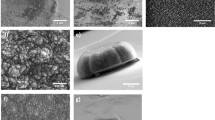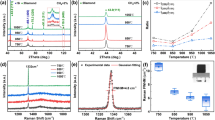Abstract
Polycrystalline diamond films with a predominant (100) texture were deposited onto silicon substrates using hot-filament chemical vapor deposition. During film deposition, different temperature gradients were created and imposed laterally across the substrate materials. Films grown under a gradient of 100 °C cm-1 displayed large (100) oriented grains. No crystallite (100) orientation was observed in the as-grown films prepared without a temperature gradient. It was observed that the diamond grain size varied as a function of the gradient. The lower gradient resulted in smaller grains and vice versa. Furthermore, the size of the grains was a function of the deposition time. The orientation of the diamond grains changed gradually across the substrate from (100) to (110) orientation as we scanned from the high-temperature to the low-temperature zone. The films were characterized using x-ray diffraction (XRD), scanning electron microscopy (SEM), atomic force microscopy (AFM), and Fourier transform infrared (FTIR) spectroscopy. XRD showed strong (400) reflections in the oriented samples. SEM results indicated the presence of smooth diamond surfaces consisting of predominantly (100) oriented platelets. As the (100) oriented diamond grains were grown on top of the (100) oriented silicon substrates, the faces were mostly aligned parallel to the substrate surface resulting in the deposition of a smooth diamond surface. AFM observations revealed the presence of steps located at the boundaries of the oriented grains. FTIR results showed the characteristic difference in hydrogen bonding in the oriented samples and gave useful information about mechanisms responsible for the orientation. Quantitative analysis was carried out to measure the H content in the films, and it was found that the oriented films contained less hydrogen. Our findings suggest that high saturation of carbon and a concentration gradient of sp3 CH2 species can be the key factor in the oriented growth of (100) diamond grains.
Similar content being viewed by others
References
L. Demuynck, J.C. Arnault, C. Speisser, R. Polini, and F. Le Normand: Mechanisms of CVD diamond nucleation and growth on mechanically scratched and virgin Si(100) surfaces. Diamond Relat. Mater. 6, 235 (1997).
I.U. Hassan, C.A. Rego, N. Ali, W. Ahmed, and I.P. O’Hare: An investigation of the structural properties of diamond films deposited by pulsed bias enhanced hot filament CVD. Thin Solid Films 355, 134 (1999).
P.N. Barnes and R.L.C. Wu: Nucleation enhancement of diamond with amorphous films. Appl. Phys. Lett. 62, 37 (1993).
S. Yugo, T. Kanai, T. Kimura, and T. Muto: Generation of diamond nuclei by electric field in plasma chemical vapor deposition. Appl. Phys. Lett. 58, 1036 (1991).
X. Jiang, X.W. Su, Q.J. Chen, and Z.D. Lin: Si implantation: A pretreatment method for diamond nucleation on a Si wafer. Appl. Phys. Lett. 66, 3284 (1995).
X. Jiang, C.P. Klages, R. Zachai, M. Hartweg, and H.J. Fusser: Epitaxial diamond thin films on (001) silicon substrates. Appl. Phys. Lett. 62, 3438 (1993).
X. Jiang, M. Fryda, and C.L. Jia: High quality heteroepitaxial diamond films on silicon. Recent progresses. Diamond Relat. Mater. 9, 1640 (2000).
S.D. Wolter, B.R. Stoner, and J.T. Glass: Textured growth of diamond on silicon via in situ carburization and bias-enhanced nucleation. Appl. Phys. Lett. 62, 1215 (1993).
Q. Chen, J. Yang, and Z. Lin: Synthesis of oriented textured diamond films on silicon via hot filament chemical vapor deposition. Appl. Phys. Lett. 67, 1853 (1995).
C. Wild, P. Koildl, W. Müller-Sebert, H. Walcher, R. Kohl, N. Herres, R. Locher, R. Samlenski, and R. Brenn: Chemical vapour deposition and characterization of smooth 100-faceted diamond films. Diamond Relat. Mater. 2, 158 (1993).
X. Li, Y. Hayashi, and S. Nishino: In-situ ellipsometry study of initial stage of bias-enhanced nucleation and heteroepitaxy of diamond on silicon(100) by hot filament chemical vapor deposition. Diamond Relat. Mater. 6, 1117 (1997).
S. Yugo, N. Nakamura, and T. Kimura: Analysis of heteroepitaxial mechanism of diamond grown by chemical vapor deposition. Diamond Relat. Mater. 7, 1017 (1998).
M. Nishitani-Gamo, T. Ando, and K. Watanabe: A nondiamond phase at the interface between oriented diamond and Si(100) observed by confocal Raman spectroscopy. Appl. Phys. Lett. 70, 1530 (1997).
M. Nishitani-Gamo, T. Ando, and K. Watanabe: Interfacial structures of oriented diamond on Si(100) characterized by confocal Raman spectroscopy. Diamond Relat. Mater. 6, 1036 (1997).
J. Plitzko, M. Rosler, and K.G. Nickel: Heteroepitaxial growth of diamond thin films on silicon. Diamond Relat. Mater. 6, 935 (1997).
S. Saada, S. Barrat, and E. Bauer-Grosse: Towards homogeneous and reproducible highly oriented diamond films. Diamond Relat. Mater. 9, 300 (2000).
T. Sharda, D.S. Misra, and D.K. Avasthi: Hydrogen in chemical vapour deposited diamond films. Vacuum 47, 1259 (1996).
B. Sun, X. Zhang, Q. Zhang, and Z. Lin: Growth mechanism and the order of appearance of diamond (111) and (100) facets. Phys. Rev. B 47, 9816 (1993).
S.J. Harris: Mechanism for diamond growth from methyl radicals. Appl. Phys. Lett. 56, 2298 (1990).
S.T. Lee and G.A. Pai: Surface phonons and CH vibrational modes of diamond (100) and (111) surfaces. Phys. Rev. B 48, 2684 (1993).
T. Ando, T. Aizawa, K. Yamamoto, Y. Sato, and M. Kamo: The chemisorption of hydrogen on diamond surfaces studied by high resolution electron energy-loss spectroscopy. Diamond Relat. Mater. 3, 245 (1999).
J.A. Chaney and C.S. Feigerle: Characterization of chlorinated chemical vapor deposited and natural (100) diamond. Surf. Sci. 425, 245 (1999).
K.M. MacNamara, B.E. Williams, K.K. Gleason, and B.E. Scruggs: Identification of defects and impurities in chemicalvapor- deposited diamond through infrared spectroscopy. J. Appl. Phys. 76, 2466 (1994).
W. Jacob and M. Unger: Experimental determination of the absorption strength of C–H vibrations for infrared analysis of hydrogenated carbon films. Appl. Phys. Lett. 68, 475 (1996).
W.J. Zhang and X. Jiang: The contribution of H+ ion etching during the initial deposition stage to the orientation grade of diamond films. Thin Solid Films 348, 84 (1999).
D. Wittorf, W. Jager, K. Urban, T. Gutheit, H. Guttler, G. Schulz, and R. Zachai: Microstructure and growth of MWCVD diamond on Si1−xCx buffer layers. Diamond Relat. Mater. 6, 649 (1997).
M. Stammler, R. Stockel, L. Ley, M. Albercht, and H.P. Strunk: Diamond nucleation on silicon during bias treatment in chemical vapour deposition as analysed by electron microscopy. Diamond Relat. Mater. 6, 747 (1997).
X. Jiang and C.L. Jia: Diamond epitaxy on (001) silicon: An interface investigation. Appl. Phys. Lett. 67, 1197 (1995).
M. Nesladek, K. Meykens, K. Haenen, J. Navratil, and C. Quaeyhaegens: Characteristic defects in CVD diamond: Optical and electron paramagnetic resonance study. Diamond Relat. Mater. 8, 1480 (1999).
Author information
Authors and Affiliations
Corresponding author
Rights and permissions
About this article
Cite this article
Titus, E., Misra, D.S., Singh, M.K. et al. Growth of (100) oriented diamond grains by the application of lateral temperature gradients across silicon substrates. Journal of Materials Research 19, 3206–3213 (2004). https://doi.org/10.1557/JMR.2004.0433
Received:
Accepted:
Published:
Issue Date:
DOI: https://doi.org/10.1557/JMR.2004.0433




